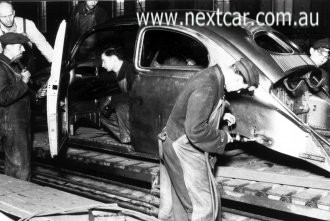|
NEWS ROAD TESTS |
 Looking Back
|
|
NEWS ROAD TESTS |
 Looking Back
|
HEAR MOTORING NEWS ON RADIO
|
 Volkswagen production line in December 1945 |
|
|
1st February, 2006 Production numbers were tiny by comparison when the incredible story of Volkswagen’s success began 60 years ago. In the midst of the ruins of war and the most difficult of ambient circumstances, a staff of 6,033 at Volkswagenwerk GmbH set out to get the assembly lines rolling. The car to be manufactured would later become known as the 'Beetle'. The origins of the car's design date back to the late 1930s. The first series-produced saloon car, with its characteristic silhouette, left the assembly line on 27th December 1945; 54 others followed by year-end. The British military government of the day had previously (on 22nd December 1945) submitted the first order for 20,000 Volkswagens, 500 custom-made vehicles with trailers for the postal service and 200 trailers for use by the Allied Forces. Delivery was scheduled to be completed by July 1946. Given the lack of available supplies in all areas, however, initial operations were difficult. While British officers were able to help get around some of the bottlenecks, it was the unrelenting persistence of a workforce struggling to build a future for itself and the improvisation skills of management which were decisive in ensuring that series production was able to be launched in the first place. In defiance of the reigning economy of scarcity, 10,020 Volkswagen automobiles did in fact leave the Wolfsburg plant in 1946. The gruelling winter months of early 1947 and a break-down of the transportation infrastructure then forced production to a three-month standstill. Eventually, however, spring brought the promise of a new blossoming for Volkswagen. The British military, which the Allied Forces had appointed as trustees of the factory (a responsibility they exercised until October 1949), paved the way for Volkswagen to enter the export business, with the first five saloons shipped out to the Netherlands in August 1947. After a national monetary reform and the transition to a fledgling market economy, the production situation experienced a veritable explosion. The Beetle, as it was eventually to become endearingly known, together with the Transporter, production of which began in March of 1950, turned the Volkswagen plant into a symbol of the so-called German Economic Miracle. In 1955, the workforce in Wolfsburg celebrated the production of its one millionth Beetle. With its successful export enterprises, the company took on an international character, not least due to its foreign production bases in Brazil, South Africa and Mexico. The millions of Beetles and Transporters sold around the world made Volkswagen an early-day global player of the automobile industry. The years 1973 to 1975 saw introduction of the Passat, Golf and Polo, enabling Volkswagen to move away from the Beetle monoculture of its past to eventually become Europe’s number-1 carmaker. Beetle production was first discontinued in Wolfsburg in 1974, then in Emden in 1978 and, finally, in Mexico, where the last of the 21,529,480 rotund icons of mobility left the assembly line on 30th July, 2003. Propelled by Ferdinand Porsche’s successful engine – which the Golf, introduced in 1974, had meanwhile helped to achieve even higher rotational speeds – Volkswagen has since transcended even the 100-million-vehicles mark –in only 60 years.
|
